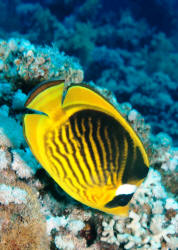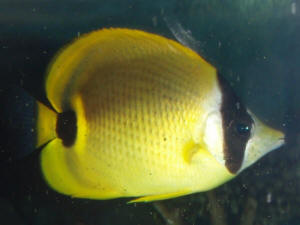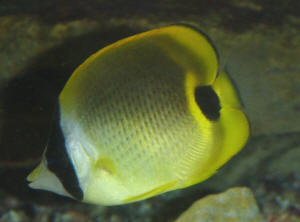|
FAQs on Butterflyfish
Identification
Related Articles: Butterflyfishes,
Related FAQs: Butterflyfish, Butterflyfish Systems, Butterflyfish
Foods/Feeding/Nutrition, Butterflyfish Compatibility, Butterflyfish Behavior, Butterflyfish Selection, Butterflyfish Disease, Hawaiian Butterflyfishes, Raccoon B/F's, Double-Saddlebacks, Threadfins,
A Chaetodon... fasciatus! Not lunula... in the
Red Sea.
|

|
 |
Butterflyfishes for Marine Aquariums
Diversity, Selection & Care
New eBooks on Amazon: Available
here
New Print Book on Create Space: Available
here
by Robert (Bob) Fenner |
|
Unidentified Butterflyfish - 09/12/08 Hi Ben
here, <Hello Ben.> I was wondering if you don't mind
identifying the Butterflyfish that I caught earlier this year in
Forster, <I guess Forster, NSW (Australia), and not Forster,
Michigan.> I can send more photos if you wish. Thanks in
advance, Ben. <Although your specimen has lots of similarity
with Chaetodon miliaris (Millet Butterflyfish) known only around
Hawaii, it lacks the vertical lines of dark scales. Instead it
seems to possess faded oblique lines like Chaetodon wiebeli.
Therefore, I believe this is a juvenile Hong Kong Butterfly (also
named Pocket Butterfly) like this one
http://filaman.ifm-geomar.de/Photos/PicturesSummary.php?StartRow=1&ID=6666&what=species&TotRec=6
which occurs the Western Pacific. It may loose the black dot at
the caudal peduncle and develop a second stripe on the mask
behind the eye with time. Your find would be one of the
southernmost occurrences of this species, if you want, inform the
Australian museum http://www.austmus.gov.au/fishes/index.cfm.
Cheers, Marco.>
|
|

|
|
Unidentified Butterflyfish II - 09/12/08 Ben
again, <Hello there.> thanks for your help, the link you
gave me showed a juvenile Hong Kong Butterflyfish that is 3.5cm
in length and the black dot on the caudal peduncle is nearly
gone, my specimen is 6cm in length with a full black dot and it
has a yellow crest around the front of the black dot. <The
sizes when Butterflyfishes change from juvenile to adult
coloration are not carved in stone.> It also had an orange
tinge to the dorsal spines, all along the top. I'm not
doubting you, <You may, since here we don't have a 100%
coincidence with literature, only an obvious similarity. You can
ask at the Australian Museum, fish department
www.amonline.net.au/fishes/ e.g. Jeff Leis (he has a research
project on fishes and in NSW) for a second opinion. > I just
want to be sure as to what it is and if you still stand by your
suggestion. <So far I do.> Here is another pic. <Thanks!
Beautiful specimen.> Oh and yes I'm in Forster, NSW.
<Cheers, Marco.>
|
|

|
|
Identity of reef fish - Mauritius 11/08/07
On a number of snorkeling outings over shallow reef I spotted a
most attractive, deep blue fish. My reference book did not
feature it & the Mauritius aquarium could not identify it
from my description. They suggested I try your site. From my
investigations I take it to be a long-nosed butterfly fish, so I
guess that makes it Family Chaetodontidae, genus Forcipiger. The
shape is spot on for this, but it's a uniform deep blue
colour - really lovely - but nowhere can I find reference to one
solid blue in colour. Can you tell me what it is, please? Geoff
Bonney. <Mmm... there are but two species of Forcipiger...
both mainly yellow... some other longish rostrumed Chaetodontids
of other genera... Chelmon, Chelmonops, Prognathodes... none of
which have blue young or adults... What we really need is a clear
pic of two... BobF, who would gladly join you in diving the
Mascarenes.>
Re: Identity of reef fish -
Mauritius 11/14/07 Thanks for sending the input
from BobF. I would also love to dive the Mascarenes, with him,
but unfortunately lack the wherewithal - & am not a qualified
diver. I would say the shape was closest to Chelmonops, but that
wonderful blue! The occasion on which I saw a little one
accompanying the larger, it was less than half the size, but
still that same deep colour. I'm beginning to think it's
something not previously identified. Now there's an exciting
prospect! The exact location, if it helps, was between the Mont
Choisy Hotel & Trou-aux-Biches, well to land-ward of the main
reef, in coral outcrops in water only about 3 metres deep. Geoff
Bonney. <I do wish you had a camera/pix... Don't think
this was/is a Chaetodontid, but don't know what. Cheers,
BobF>
|
Wrought Iron Angel - 06/17/07 Hello MR. Fenner I
hope that you do not mind the email, please excuse the intrusion.
<Please... write to Crew@WetWebMedia.com> was wondering if you
had any first hand experience with a wrought iron angel <There is no
such animal... you likely mean the Butterflyfish, Chaetodon
daedalma...> and a reef tank. Thinking about adding one to my 180g
reef system which is SPS and LPSs ( Scolymia, lympho's,
symphilia's, Gonioporas) no clams or elegance or torch's
etc. do they have a tendency to be unfriendly to my corals? any input
would be appreciated, thank you for your time and advice. Stephen,
concord, Massachusetts. <Try the correct common and scientific name
for a further search. BobF>
Heniochus identification Hi Crew,
This one's been on the chat forum for a
week with no takers, so I thought I'd see if y'all (southern,
non genderized version of 'you guys') could help.
I'm 3 months new to the hobby and trying to
build toward a reef tank by learning the basics with a few fish that
won't have to be gotten rid of as I add more invert's over
time. LFS has some nice Bannerfish that
they've labeled as 'Heniochus butterflies',
which they obviously are. Sixty-four dollar question is are they H.
diphreutes or H. acuminatus. My readings have convinced me to avoid
acuminatus (Longfin), and likewise that diphreutes (schooling
Bannerfish) should be more 'reef-safe'. <Mmm, six of one...
Mostly the trade sees H. acuminatus... though diphreutes does come to
us via Hawai'i occasionally...> I've read what I can find on
differential ID between the two and am aware of the points made by
Scott Michael. Unfortunately without both species to compare
simultaneously I just can't be sure which species these fish really
are. Any suggestions? <Side by side these two are unmistakable...
but not having both, hard to discern by description. H. diphreutes
really has a "little mouth" is my best discriminating
factor... though the banding color differences are noted on WWM>
Thanks in advance for your consideration and
for all the fantastic support "y'all" provide the hobby.
Your website and books have already provided tremendous assistance even
in my short time in the hobby. Keep up the great work! Florida Boy
<Glad to find we've been of service. Bob Fenner>
 |
Butterflyfishes for Marine Aquariums
Diversity, Selection & Care
New eBooks on Amazon: Available
here
New Print Book on Create Space: Available
here
by Robert (Bob) Fenner |
|
|

